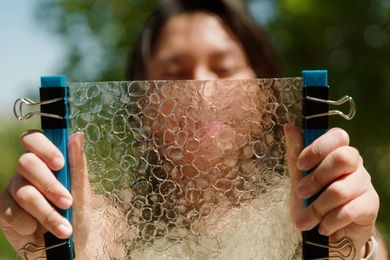Who said it's hard to get into MIT?
A bird showed just how easy it could be early this month when it flew through an open window into the Pierce Engineering Laboratory lounge in civil and environmental engineering on the first floor of Building 1.
Attempts to capture it there drove the tiny bird-believed to be a starling-into the nearby office of Professor Joseph M. Sussman at the corner of Massachusetts Avenue and Memorial Drive, where it promptly dropped out of sight.
After Physical Plant people had come and gone, and some two hours after the bird's arrival, Professor Sussman heard fluttering and discovered the visitor in a bookshelf perched on some computer tomes.
An ardent photographer who always keeps a camera on hand, he photographed the bird.
He also put in another bird call to Physical Plant, summoning Rui Borges, evening shift supervisor in building services, and Anthony J. Pallotta.
Mr. Borges proved himself a capable hunter, grabbing the bird and putting into a box. But only for a moment. After having his picture taken by Professor Sussman, he took the starling outside and released it.
"It went on its merry way," he said, adding that his job provides "something new all the time."
----------
Political correctness-what's at issue and what's at stake-is the subject of a lecture that Dr. Robin Kilson, assistant professor of history, will deliver tomorrow to entering Harvard and Radcliffe students as part of their orientation activities.
According to Professor Kilson, who graduated from Harvard and Radcliffe colleges in 1983 and is a 1993-94 Bunting Fellow at Radcliffe, the idea of political correctness has become so embedded in popular culture that the real issues-racism, sexism and classism-have been obscured.
"I challenge incoming freshmen as well as faculty to move ahead with meaningful dialogue and to truly bring multiculturalism to our college campuses, said Dr. Kilson, who received her master's and doctoral degrees in history from Harvard.
During her Bunting fellowship, she researched the history of black women and American academia and last January was co-organizer of the first national conference of black women academics. She has two forthcoming books based on her research and on the proceedings from the conference.
----------
Dr. Robert J. McCunney, director of the Medical Department's Environmental Medical Service, is editor of the recently published textbook, A Practical Approach to Occupational and Environmental Medicine.
The book, published by Little, Brown and Company, is a second edition of an earlier version. It is an official publication of the American College of Occupational and Environmental Medicine, which will receive royalties from the sale of the book.
According to its publisher, the book provides a "practical approach" to the field, covering occupational services and illnesses, evaluations of occupational health hazards, challenges and opportunities in occupational medicine and environmental medicine.
----------
QUOTE:
"People expect certain products to sound a certain way, and when they don't it's a problem."-Dr. Richard H. Lyon, professor of mechanical engineering, in a Wall Street Journal story on sound-quality engineering.
CLIPS:
How the MIT Press came to publish American Ground Zero: The Secret Nuclear War, is told by Amy Gamerman of The Wall Street Journal. Photographer Carole Gallagher's book recounts, in photographs and interviews, the aftermath of atomic bomb testing between 1951 and 1963 in the Nevada desert.
As told by Ms. Gamerman, some 30 publishers rejected Ms. Gallagher's proposed book on grounds that it was too depressing or not graphic enough.
"Finally," she writes, "her proposal reached Roger Conover, an editor at MIT Press.
"Mr. Conover was struck by the pictures and felt `there was a special connection between the book and the Massachusetts Institute of Technology-many MIT scientists had been involved in the Manhattan Project and other atomic research. Mr. Conover sent Ms. Gallagher's manuscript to several scientists, among them Kosta Tsipis, an MIT physicist active in nuclear arms control, who `endorsed it in the strongest possible terms.'"
The book, published by The MIT Press in 1993, has been put out in paperback by Random House.
----------
The List Visual Arts Center continues to grow in stature-it was recently chosen as one of just eight American museums to program the new American Center in Paris. "Leon Golub and Nancy Spero: War and Memory," a retrospective of the artists' work spanning 40 years, is being organized by List director Katy Kline and curator Helaine Posner and opening in Paris this month , returning to MIT in the spring.
In contributing to the program, the museum joins highly respected institutions including the Whitney Museum of Contemporary Art, the Art Institute of Chicago and the Los Angeles Museum of Contemporary Art-"an impressive roster that puts MIT in the best of company," Christine Temin of the Boston Globe noted.
A version of this article appeared in the September 28, 1994 issue of MIT Tech Talk (Volume 39, Number 6).





